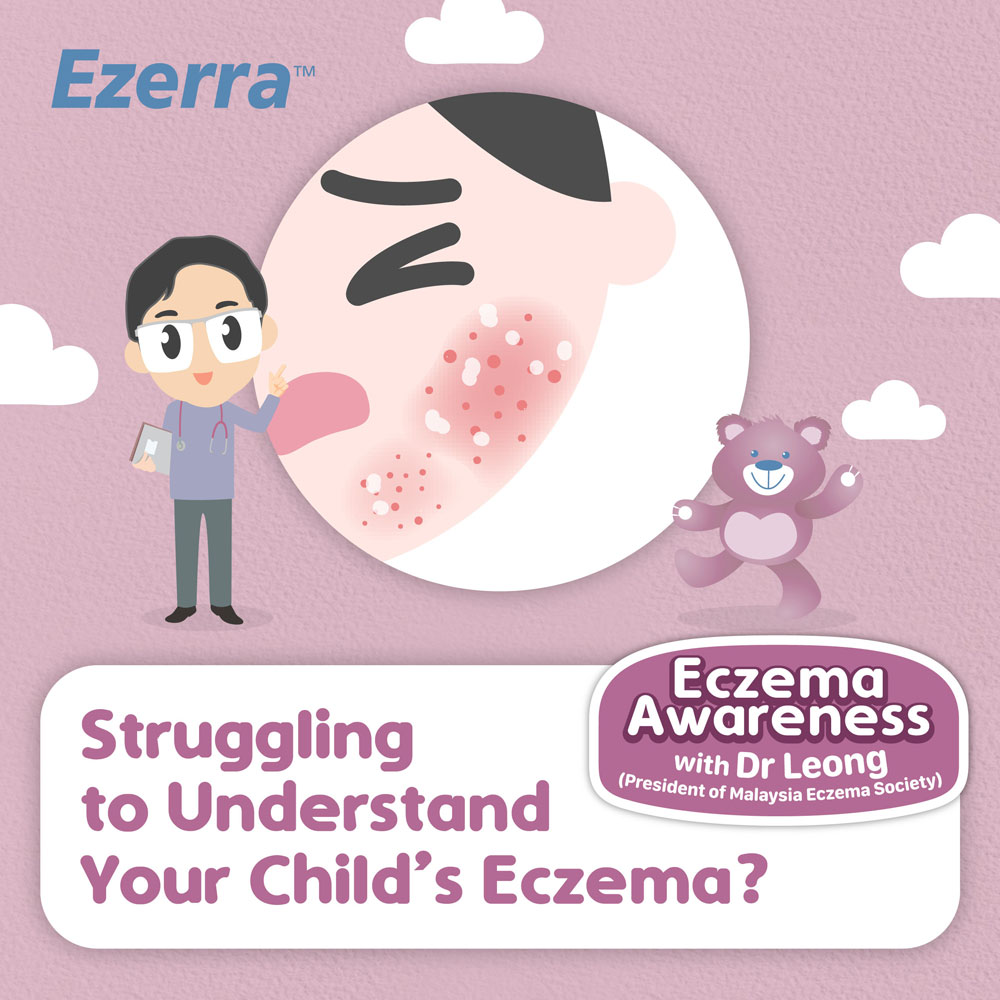Eczema 101: Understanding Your Child’s Eczema
Parents, we understand that you are probably suffering as much as your child does from eczema. The frustration, confusion and misery could sometimes get unbearable. Here’s the things you need to know about your child’s eczema.
What is eczema or dermatitis?
Many parents are pointing fingers at cow’s milk, goat’s milk, soy-based milk, eggs, seafood, etc when it comes to child’s eczema. In no time, they will start to practise self diet manipulation which is not recommended by most international guidelines or authorities. Therefore, it is important that you understand what exactly eczema is to help manage your child’s symptoms.
Eczema is not a form of food allergy but rather a skin inflammation caused by environmental insults. The inflammation occurs mainly at the outer layer of the skin known as epidermis and part of the superficial dermis, and this is good news! This is mainly because the epidermis naturally possesses the capacity to fully regenerate in over 4-6 weeks. After the skin is damaged, if the epidermis is offered an ideal environment over the next 4-6 weeks, it will fully recover. This is what we call the epidermis healing cycle. In another word, if your baby develops eczema over the back of the hand, over the next 2-4 weeks, as you use either steroid or non-steroidal cream and put eczema into remission and use regular moisturiser, with the absence of further insults, the skin will be back to normal over the next 4-6 weeks. Although certain patients’ skin may have a bit of discoloration, if the well-being of the eczema skin area is maintained, the skin color will recover over the next 2-3 months. Otherwise, if left uncontrolled, the eczema will commonly progress from early eczema to long-term eczema in which the skin gets thickened over time and results in leathery skin. Among the eczema kids, some of them may march on to another system, which we call an allergic march and some other forms of allergic diseases.
Is eczema common in Malaysia?
The answer is a big fat YES! In fact, it is getting even more common over the last few decades due to progressive urbanisation, industrialisation and pollution. Based on a local data dated back in 1995, about 9.5% of the students in Malaysia suffer from eczema and there is an increase of 0.5% each year. This is especially true in major cities like Kuala Lumpur, Johor Bahru, Ipoh and Penang. In other words, 1 of 5 students suffer from atopic dermatitis at a certain point in their lives and atopic eczema is more common in areas that are urbanised and possess a high standard of hygiene.
Is eczema restricted to infants and young children?
No, it is not restricted to only infants and young children. Although the majority of the sufferers were diagnosed with eczema in the first few years of life, eczema may affect anyone at any age from babies as young as the first few months of life to toddlers, teenagers, young adults, adults and even the elderly. In short, atopic dermatitis is a very common skin disorder in our community.
What are the clinical signs and symptoms of atopic eczema?
The clinical signs and symptoms of eczema are so dynamic that it cannot be represented in just a single, fixed image. Some of the factors that affect the final appearance of eczema include; how chronic or how long standing is the eczema. The longer the eczema, the skin will become discolored and thicker. In fact, some of them may have little bumps over those areas and we call them prurigo nodules. This is the explanation as to why there is no one-size-fits-all solution when it comes to atopic eczema. However, it is very important to control your child’s eczema promptly as it may cause the skin to darken, discolour and eventually result in leathery skin over time. Depending on the severity of the inflammation, some eczema sufferers may experience intense itching, blisters, ruptures and also get secondary infection with watery weepy surfaces.
Another factor that may affect the appearance of eczema is skin colour. Most people think of eczema as red, dry and itchy spots as to how it appears on light skin. However, in darker skin colour, the redness may not be reliable. Therefore, a different diagnosis has to be used on darker skin to look for eczema symptoms; you need to feel for the scaliness and ask if there is any itchiness. One thing for sure, whether you have bright skin, brown skin or darker skin, whether you have acute or chronic eczema, one of the most consistent and common features that is present with eczema is intense itchiness. It is more painful than pain when it goes beyond a certain intensity because when you itch, you tend to use scratch to induce pain to overcome itch but unfortunately it creates more itch and the vicious cycle goes on. It does not only affect the physical well-being of the child, but also socially, mentally and financially. One of the parents may also need to quit their job in order to take care of their child who suffers from eczema.
In the next article, we will be sharing about the management of your child’s eczema. Please stay tuned!
Prepared by:
Dr Leong Kin Fon
President of Malaysia Eczema Society
Disclaimer: The content of this article is for educational purposes only. Seek the advice of your medical provider regarding any questions or concerns you have about your baby’s specific skin condition.
P/S: We are proud to present our Childhood Eczema Awareness series featuring Dr. Leong, the President of Malaysia Eczema Society! Watch the complete series at our YouTube channel to find out more about the rising prevalence of childhood eczema in Malaysia!









